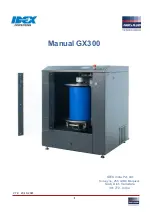
and/or
3
, they can be used as a source of vari-
able constant voltage, from 0 to +5V, or from 0
to –5V. On the other hand, combining the offset
with a signal fed to the corresponding inputs
facilitates conversion from bipolar to unipolar
voltages (by using +5V offset), or converting
from unipolar to bipolar (by using –5V offset).
The resulting signal or voltage, after being
manually attenuated by the
level
knob
5
, is
available at the corresponding
out
socket
6
.
A bi-color LED
7
indicates the value and po-
larity of the individual
out
voltage via bright-
ness and color, wherein red indicates positive
and green indicates negative. For audio sig-
nals, fast blinking of red and green yields a yel-
low-orange mixture with intensity indicating
signal level.
MIXING
A cascaded arrangement of summers allows
for a multitude of mixing configurations. First
of all, note that patching a cable into an in-
dividual output excludes the corresponding
channel from further mixing (however, it does
not exclude it from taking part in additional
processing for
func
outputs). To mix four
signals, feed them into inputs and adjust the
level
knobs
4
. The resulting signal is avail-
able at the
all
socket
9
(make sure that
nothing is plugged into
1+2
output socket
8
). Additionally, you can also use the invert-
ing inputs
2
to mix up to eight signals.
To use Samara as two independent 2:1 mixers,
use both
1+2
8
and
3+4
9
outputs. Patch-
ing a cable to
1+2
output breaks the internal
connection, so that these two channels are no
longer mixed with channels
3
and
4
at the
all
output. Again, using the inverting inputs
allows for two four-component mixes.
Since mixing multiple hot signals with little
attenuation usually yields distortion (espe-
cially at the
all
output
8
), Samara offers
a soft-clipping solution. It can be engaged by
putting a jumper on the two–pin header la-
beled
soft clip
at the back of the unit.
Additionally, optional –6dB (2:1) attenuation
is available independently for
1+2
and
3+4
summers by moving two jumpers marked
at
-
ten
from the upper to lower position. Switch-
ing just one jumper does not affect the ampli-
tude on the second summer. Note that the mix
at
all
will then have unequal proportions. The
jumpers do not affect the operation of the addi-
tional processing at the multi-functional
func
outputs
10
11
.
WAVEFORM PROCESSING FUNCTIONS
In addition to linear mixing, Samara features
a multi–function signal processing unit that
operates on the four
out
signals from chan-
nels
1
–
4
. The results of processing are deliv-
ered to
func
outputs
10
11
. These functions
are implemented in a precise analog circuit
under digital control. A small DSP chip mon-
itors the signals and operates a number of
analog CMOS switches that route them (or
4


























